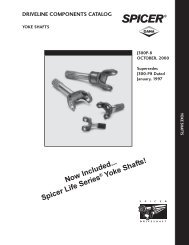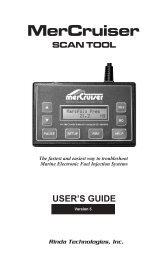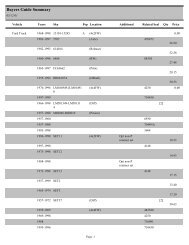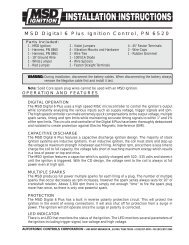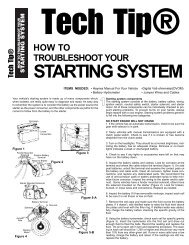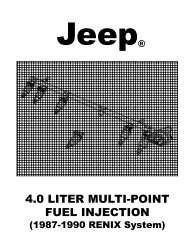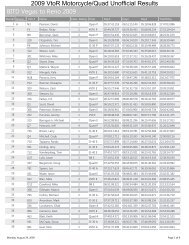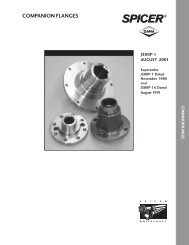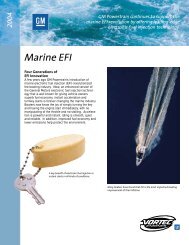- Page 1 and 2:
For New Technology Network R corpor
- Page 3 and 4:
Warranty NTN warrants, to the origi
- Page 5 and 6:
TECHNICAL DATA CONTENTS 1. Classifi
- Page 7 and 8:
Classification and Characteristics
- Page 9 and 10:
Classification and Characteristics
- Page 11 and 12:
Classification and Characteristics
- Page 13 and 14:
Bearing Selection Select bearing’
- Page 15 and 16: Bearing Selection 2.3 Selection of
- Page 17 and 18: Load Rating and Life 3. Load Rating
- Page 19 and 20: Load Rating and Life where, Lna : A
- Page 21 and 22: Bearing Load Calculation 4. Bearing
- Page 23 and 24: Bearing Load Calculation 4.1.2 Chai
- Page 25 and 26: Bearing Load Calculation 4.4 Equiva
- Page 27 and 28: Bearing Load Calculation 4.5 Allowa
- Page 29 and 30: Bearing Load Calculation Fr2 70 K
- Page 31 and 32: Boundary Dimensions and Bearing Num
- Page 33: Boundary Dimensions and Bearing Num
- Page 36 and 37: Bearing Tolerances Table 6.3 Tolera
- Page 38 and 39: Bearing Tolerances Table 6.4 Tolera
- Page 40 and 41: Bearing Tolerances Table 6.5 Tolera
- Page 42 and 43: Bearing Tolerances Table 6.6 Tolera
- Page 44 and 45: Bearing Tolerances Table 6.7 Tolera
- Page 46 and 47: Bearing Tolerances 6.2 Chamfer meas
- Page 48 and 49: Bearing Tolerances 6.3 Bearing tole
- Page 50 and 51: Bearing Fits 7.3.2 Recommended Fits
- Page 52 and 53: Bearing Fits Table 7.2 (3) Housing
- Page 54 and 55: Bearing Fits Table 7.5 Numeric valu
- Page 56 and 57: Bearing Fits Table 7.6 Fits for inc
- Page 58 and 59: Bearing Internal Clearance and Prel
- Page 60 and 61: Bearing Internal Clearance and Prel
- Page 62 and 63: Bearing Internal Clearance and Prel
- Page 64 and 65: Bearing Internal Clearance and Prel
- Page 68 and 69: Bearing Internal Clearance and Prel
- Page 70 and 71: Allowable Speed 9. Allowable Speed
- Page 72 and 73: Lubrication 11. Lubrication 11.1 Lu
- Page 74 and 75: Lubrication (1) Base oil Natural mi
- Page 76 and 77: Lubrication 11.4 Solid grease (For
- Page 78 and 79: Lubrication Bearing operating Lubri
- Page 80 and 81: External bearing sealing devices 12
- Page 82 and 83: External bearing sealing devices Ty
- Page 84 and 85: Bearing Materials 13.2 Cage materia
- Page 86 and 87: Shaft and Housing Design 14.2 Beari
- Page 88 and 89: Bearing Handling 15. Bearing Handli
- Page 90 and 91: Bearing Handling a) Installation on
- Page 92 and 93: Bearing Handling 15.4 Post installa
- Page 94 and 95: Bearing Handling Fig. 15.24 shows t
- Page 96 and 97: Bearing Damage and Corrective Measu
- Page 98 and 99: Technical Data Axial displacement m
- Page 100 and 101: Technical Data 17.4 Fitting surface
- Page 102 and 103: A-100
- Page 104 and 105: INDEX OF BEARING TABLES Deep Groove
- Page 107 and 108: Deep Groove Ball Bearings Open type
- Page 109 and 110: Deep Groove Ball Bearings bearing i
- Page 111 and 112: Deep Groove Ball Bearings D D1 rN r
- Page 113 and 114: Deep Groove Ball Bearings D D1 rN r
- Page 115 and 116: Deep Groove Ball Bearings D D1 rN r
- Page 117 and 118:
Deep Groove Ball Bearings D D1 rN r
- Page 119 and 120:
Deep Groove Ball Bearings D D1 rN r
- Page 121 and 122:
Deep Groove Ball Bearings D D1 rN r
- Page 123 and 124:
Deep Groove Ball Bearings Equivalen
- Page 125 and 126:
Deep Groove Ball Bearings Equivalen
- Page 127 and 128:
Deep Groove Ball Bearings Equivalen
- Page 129:
Expansion Compensating Bearings Da
- Page 132 and 133:
Miniature and Extra Small Bearings
- Page 134 and 135:
Miniature and Extra Small Ball Bear
- Page 136 and 137:
Miniature and Extra Small Ball Bear
- Page 138 and 139:
Miniature and Extra Small Ball Bear
- Page 140 and 141:
Miniature and Extra Small Ball Bear
- Page 143 and 144:
Angular Contact Ball Bearings Angul
- Page 145 and 146:
Angular Contact Ball Bearings 2. St
- Page 147 and 148:
Single and Duplex Arrangements Db r
- Page 149 and 150:
Single and Duplex Arrangements Db r
- Page 151 and 152:
Single and Duplex Arrangements Db r
- Page 153 and 154:
Single and Duplex Arrangements Db r
- Page 155 and 156:
Single and Duplex Arrangements Db r
- Page 157 and 158:
Single and Duplex Arrangements Db r
- Page 159 and 160:
High Speed Single and Duplex Arrang
- Page 161 and 162:
High Speed Single and Duplex Arrang
- Page 163 and 164:
High Speed Single and Duplex Arrang
- Page 165 and 166:
High Speed Single and Duplex Arrang
- Page 167 and 168:
Ultra-High Speed Angular Contact Ba
- Page 169 and 170:
B-67
- Page 171 and 172:
Ceramic Ball Angular Contact Ball B
- Page 173 and 174:
Four-Point Contact Ball Bearings QJ
- Page 175 and 176:
Double Row Angular Contact Ball Bea
- Page 177:
Double Row Angular Contact Ball Bea
- Page 180 and 181:
Self-Aligning Ball Bearings B r ra
- Page 182 and 183:
Self-Aligning Ball Bearings B r ra
- Page 184 and 185:
Self-Aligning Ball Bearings B r ra
- Page 186 and 187:
Adapters (for self-aligning ball be
- Page 188 and 189:
Adapters (for self-aligning ball be
- Page 191 and 192:
Cylindrical Roller Bearings Cylindr
- Page 193 and 194:
Cylindrical Roller Bearings 2. Stan
- Page 195 and 196:
Cylindrical Roller Bearings ra r1a
- Page 197 and 198:
Cylindrical Roller Bearings ra r1a
- Page 199 and 200:
Cylindrical Roller Bearings ra r1a
- Page 201 and 202:
Cylindrical Roller Bearings ra r1a
- Page 203 and 204:
Cylindrical Roller Bearings ra r1a
- Page 205 and 206:
Cylindrical Roller Bearings ra r1a
- Page 207 and 208:
Cylindrical Roller Bearings ra r1a
- Page 209 and 210:
Cylindrical Roller Bearings ra r1a
- Page 211 and 212:
Cylindrical Roller Bearings ra r1a
- Page 213 and 214:
L Type Loose Rib B2 B2 r1 r1 B1 d d
- Page 215 and 216:
L Type Loose Rib B2 B2 r1 r1 B1 d d
- Page 217 and 218:
Multi-Row Cylindrical Roller Bearin
- Page 219 and 220:
Multi-Row Cylindrical Roller Bearin
- Page 221 and 222:
Multi-Row Cylindrical Roller Bearin
- Page 223 and 224:
Four-Row Cylindrical Roller Bearing
- Page 225 and 226:
Four-Row Cylindrical Roller Bearing
- Page 227 and 228:
Four-Row Cylindrical Roller Bearing
- Page 229 and 230:
Four-Row Cylindrical Roller Bearing
- Page 231:
Four-Row Cylindrical Roller Bearing
- Page 234 and 235:
Tapered Roller Bearings Table 1 (co
- Page 236 and 237:
Tapered Roller Bearings Inch Tapere
- Page 238 and 239:
Tapered Roller Bearings Inch Tapere
- Page 240 and 241:
Tapered Roller Bearings Metric syst
- Page 242 and 243:
Tapered Roller Bearings Metric syst
- Page 244 and 245:
Tapered Roller Bearings Metric syst
- Page 246 and 247:
Tapered Roller Bearings Metric syst
- Page 248 and 249:
Tapered Roller Bearings Metric syst
- Page 250 and 251:
Tapered Roller Bearings Metric syst
- Page 252 and 253:
Tapered Roller Bearings Metric syst
- Page 254 and 255:
Tapered Roller Bearings Metric syst
- Page 256 and 257:
Tapered Roller Bearings Metric syst
- Page 258 and 259:
Tapered Roller Bearings Inch system
- Page 260 and 261:
Tapered Roller Bearings Inch system
- Page 262 and 263:
Tapered Roller Bearings Inch system
- Page 264 and 265:
Tapered Roller Bearings Inch system
- Page 266 and 267:
Tapered Roller Bearings Inch system
- Page 268 and 269:
Tapered Roller Bearings Inch system
- Page 270 and 271:
Tapered Roller Bearings Inch system
- Page 272 and 273:
Tapered Roller Bearings Inch system
- Page 274 and 275:
Tapered Roller Bearings Inch system
- Page 276 and 277:
Tapered Roller Bearings Inch system
- Page 278 and 279:
Tapered Roller Bearings Inch system
- Page 280 and 281:
Tapered Roller Bearings Inch system
- Page 282 and 283:
Tapered Roller Bearings Inch system
- Page 284 and 285:
Tapered Roller Bearings Inch system
- Page 286 and 287:
Tapered Roller Bearings Inch system
- Page 288 and 289:
Tapered Roller Bearings Inch system
- Page 290 and 291:
Tapered Roller Bearings Inch system
- Page 292 and 293:
Tapered Roller Bearings Inch system
- Page 294 and 295:
Tapered Roller Bearings Inch system
- Page 296 and 297:
Multi-Row Tapered Roller Bearings O
- Page 298 and 299:
Multi-Row Tapered Roller Bearings O
- Page 300 and 301:
Multi-Row Tapered Roller Bearings O
- Page 302 and 303:
Multi-Row Tapered Roller Bearings O
- Page 304 and 305:
Multi-Row Tapered Roller Bearings O
- Page 306 and 307:
Multi-Row Tapered Roller Bearings O
- Page 308 and 309:
Multi-Row Tapered Roller Bearings O
- Page 310 and 311:
Multi-Row Tapered Roller Bearings I
- Page 312 and 313:
Multi-Row Tapered Roller Bearings I
- Page 314 and 315:
Four Row Tapered Roller Bearings C2
- Page 316 and 317:
Four Row Tapered Roller Bearings C2
- Page 318 and 319:
Four Row Tapered Roller Bearings C2
- Page 320 and 321:
Four Row Tapered Roller Bearings C2
- Page 322 and 323:
Four Row Tapered Roller Bearings C2
- Page 324 and 325:
Four Row Tapered Roller Bearings C2
- Page 326 and 327:
Four Row Tapered Roller Bearings C2
- Page 328 and 329:
Four Row Tapered Roller Bearings C2
- Page 331 and 332:
Spherical Roller Bearings 1. Types,
- Page 333 and 334:
Spherical Roller Bearings 5. Adapte
- Page 335 and 336:
Spherical Roller Bearings ra Da ra
- Page 337 and 338:
Spherical Roller Bearings ra Da ra
- Page 339 and 340:
Spherical Roller Bearings ra Da ra
- Page 341 and 342:
Spherical Roller Bearings ra Da ra
- Page 343 and 344:
Spherical Roller Bearings ra Da ra
- Page 345 and 346:
Spherical Roller Bearings ra Da ra
- Page 347 and 348:
Spherical Roller Bearings ra Da ra
- Page 349 and 350:
Spherical Roller Bearings ra Da ra
- Page 351 and 352:
Spherical Roller Bearings ra Da ra
- Page 353 and 354:
Spherical Roller Bearings ra Da ra
- Page 355 and 356:
Adapter (For spherical roller beari
- Page 357 and 358:
Adapter (For spherical roller beari
- Page 359 and 360:
Withdrawal Sleeves (For spherical r
- Page 361 and 362:
Withdrawal Sleeves (For spherical r
- Page 363 and 364:
Withdrawal Sleeves (For spherical r
- Page 365 and 366:
Withdrawal Sleeves (For spherical r
- Page 367 and 368:
Double Row Angular Contact Thrust B
- Page 369 and 370:
Double Row Angular Contact Thrust B
- Page 371 and 372:
High Speed Duplex Angular Contact T
- Page 373 and 374:
High Speed Duplex Angular Contact T
- Page 375 and 376:
Self-Aligning Roller Thrust Bearing
- Page 377 and 378:
Self-Aligning Roller Thrust Bearing
- Page 379 and 380:
Self-Aligning Roller Thrust Bearing
- Page 381 and 382:
Locknuts, Lockwashers & Lockplates
- Page 383 and 384:
Locknuts Reference withdrawal sleev
- Page 385 and 386:
Locknuts Reference bore no. 3 locko
- Page 387 and 388:
Nuts Reference withdrawal sleeve no
- Page 390 and 391:
Lockwashers Series AW ƒ r2 B2 ƒ1
- Page 392 and 393:
Lockwashers Series AWL ƒ r2 B2 ƒ
- Page 394 and 395:
Catalog List & Appendix Table
- Page 396 and 397:
Catalog List CATALOG TITLES CATALOG
- Page 398:
Appendix Table SI-customary unit co




